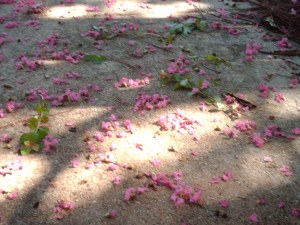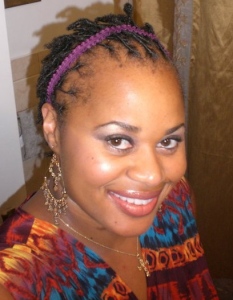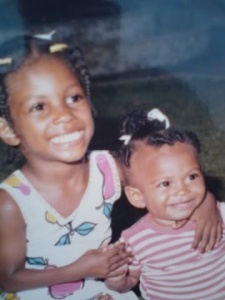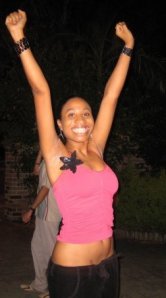 Life has slowed down considerably since I graduated and moved back to Louisiana. I now spend my days working on my novel, filling out applications, taking long walks to Granny’s house, cooking, and catching up on last season’s True Blood (the new season started Sunday!). I haven’t been reading as much; I went from reading one or two novels a week, to starting three and not finishing any this last month. It feels like my days are all lazy days. Though there’s always a lot to do and I try to accomplish something each day, I know I can always do more.
Life has slowed down considerably since I graduated and moved back to Louisiana. I now spend my days working on my novel, filling out applications, taking long walks to Granny’s house, cooking, and catching up on last season’s True Blood (the new season started Sunday!). I haven’t been reading as much; I went from reading one or two novels a week, to starting three and not finishing any this last month. It feels like my days are all lazy days. Though there’s always a lot to do and I try to accomplish something each day, I know I can always do more.
The thing is, I have ample alone time (something I crave as a writer), but I’m discovering that even that can get frustrating. To my surprise, I’m beginning to feel too alone. In fact that’s how the walks to Granny’s house started. I needed the exercise, yes, but really I needed stimulation; writing requires my senses to be alive. How can I create a world the reader will be happy to be immersed in if I don’t get out and explore and experience the world about me?
That walk through the neighborhood, past the park, Botanic Garden, fire station and police training ground, is quite stimulating. The French architecture, huge

Botanic Garden Sunflower
old trees and flowers are visually stimulating, while the herbs at the Botanic Garden are olfactive. Passing joggers smile and wave, giving me a sense of belonging, and it’s kinda cool to have a sea of soon-to-be -policemen part as I jog through with a reggae and soca soundtrack on my iPod pushing me on. All these little things add to the experience, but the talks in Granny’s kitchen are the real inspiration. It’s amazing how talking to the right person can make me feel more myself.
Saturday, I attended a party (baby shower/birthday celebration for the daddy) and delighted in the opportunity to interact with a new circle of women. There were so many new characters, so many personalities to analyse and so many stories to piece together as I tried to figure out how these women were connected. This led me to think about Dacia Maraini’s Woman at War and Vannina, the first person narrator and protagonist who grows through her interactions with a new circle of friends. Vannina never plans it, but while on vacation in Addis, then Naples, the people she associates with, from all walks of life, change her. She tries to, but finds she can’t go back to life as it was in Rome.
 Maraini uses gossip as a literary device to make a quick connection with the reader and uses this protagonist in particular, to demonstrate how personal interaction can influence a person. Vannina, a twenty-five-year-old Roman teacher, is introduced at the very onset of her summer vacation and the reader finds her to be a reliable first-person narrator, because she “gossips.” “So starts my holiday,” she writes in her diary and it is important to note that keeping a diary isn’t something she is driven to out of necessity. As far as the reader can tell, she just does it. This means she has no audience to address, no jury or judge to appeal to, and no listener to impress or persuade. The reader can take her at her word and not feel coerced or manipulated into liking or caring about her.
Maraini uses gossip as a literary device to make a quick connection with the reader and uses this protagonist in particular, to demonstrate how personal interaction can influence a person. Vannina, a twenty-five-year-old Roman teacher, is introduced at the very onset of her summer vacation and the reader finds her to be a reliable first-person narrator, because she “gossips.” “So starts my holiday,” she writes in her diary and it is important to note that keeping a diary isn’t something she is driven to out of necessity. As far as the reader can tell, she just does it. This means she has no audience to address, no jury or judge to appeal to, and no listener to impress or persuade. The reader can take her at her word and not feel coerced or manipulated into liking or caring about her.
Vannina doesn’t aim to cloak, hide or explain away any aspects of her personality. The reader can trust her. She records her story assuming absolute privacy and appears quite comfortable with keeping a diary. She doesn’t fear prying eyes because not even Giacinto, her semi-literate husband, will read what she’s written. Maraini presents Vannina as having no reason to lie, and like Tota, a native of Addis who quickly befriends Vannina with her penchant for gossip, Vannina doesn’t hesitate to reveal the most scandalous details about everyone and everything in her diary. The text is designed to allow the reader to get to know Vannina in much the same way she gets to know her new acquaintances and friends. The reader can therefore trust that Vannina has no reason to deceive, and since she doesn’t have to worry about what is appropriate, she can talk freely, sharing all the good gossip. The text takes the form of an uncensored dialogue Vannina has with herself so that the reader can eavesdrop on a conversation that gets real intimate real quick.
Though Maraini lets the reader know that Vannina can be a bore (she appears meek and
 subservient in her interactions with the other characters), the text is chockfull of personal reflections and secret confessions. Maraini allows her protagonist to use language that is raw and honest. When she writes in her diary her voice is strong, direct and bold. She notes the most exciting and bizarre things in the most succulent language and writes with confidence and reckless abandon, precisely because she never intends an audience.
subservient in her interactions with the other characters), the text is chockfull of personal reflections and secret confessions. Maraini allows her protagonist to use language that is raw and honest. When she writes in her diary her voice is strong, direct and bold. She notes the most exciting and bizarre things in the most succulent language and writes with confidence and reckless abandon, precisely because she never intends an audience.
Maraini places the reader in the position of ultimate gossip buddy to Vannina, much like Vanina’s early interaction with Tota, who “started talking straight away in a carefree, natural way as if we were two old friends” the narrative voice connects with the reader as it is straightforward and has an intimate and familiar tone (9). This approach lends the work a conversational tone and the familiarity with which the narrator addresses the reader suggests that Maraini uses the first-person narrative voice to evoke gossip, and by extension, folklore.
Like gossip, the stories Vannina records seem shocking and outrageous at first, but one advantage for Maraini is that the reader doesn’t have to guess at what Vannina might be lying about. Maraini’s technique of plunging the reader into Vannina’s story, just as easily as one would “fall” into a bit of gossip, takes the reader as close as possible to what the protagonist really thinks. She also applies an oral tone to the work by using dialogue—usually without tags— throughout the text as a means of inferring this uninhibited speech, or gossip. In this way, the reader gets the story directly from Vannina, not a third party. Maraini aims to recreate a natural meeting between protagonist and reader and she draws a parallel between the new relationships Vannina strikes up with people like Tota and Suna, and the simultaneous impression she makes with the reader.
As Vannina’s transformation from subservient wife to independent woman isn’t explicitly stated as being her intention at the beginning of the work, and does not become her focus at any particular point in the work, her growing self-awareness is presented by the author as being organic, unforced. The shift occurs subconsciously, “I was sunk into a dark and painful sleep for days. On the fifth day I had a strange and obscurely revealing dream which changed the course of my life” (279). Vannina’s transformation/evolution is presented as occurring, naturally, and as unconsciously as her original social conditioning must have.
In this way, Maraini presents Vannina as somewhat in-condemnable. The author doesn’t try to distance herself from her protagonist and Vannina appears to have an acceptable reputation though she engages in actions and events the reader may not approve of. This encourages the reader to side with her, in the same way Vannina chooses not to judge her new friends, and excuse her improprieties.
have an acceptable reputation though she engages in actions and events the reader may not approve of. This encourages the reader to side with her, in the same way Vannina chooses not to judge her new friends, and excuse her improprieties.
Vannina eventually comes to admit to herself that some things she believed to be true about herself and the nature of a woman was only in an effort to gain the approval of the people she deemed to be better than her. This belief is a part of her social conditioning. Like a girl, she still wants to be liked, so she is willing to do things not in her own best interest; “I wanted to say no. But I let myself be carried away by the pleasure of saying yes, of being ingratiating, carrying out a task without question, so that I could then be rewarded with the approval of those who were cleverer and more confident than myself. It was just what they expected from me, naturally, it was my role as a woman” (Maraini 110). Vannina grows to understand that her unquestioning acceptance of these norms is unreasonable. Her obedience therefore, doesn’t reflect her shifting self-image or improve her life. She learns to be more selfish once she has the opportunity to understand the extreme measures people will take for presumed personal advancement. She starts to form her own opinions and begins to take responsibility for her actions.
Maraini, in the tradition of a folklorist, seems to value the oral text as primary in the way she presents Vannina’s story. The diary format, the gossipy tone, and the repeated use of dialogue all suggest an oral text. The stories a society chooses to tell and retell form the fabric of the culture as “[w]ith time and repetition, some examples of human expression become pervasive and common place. When they do, we conceive them to be traditions or traditional; and we can identify them individually or collectively as folklore” (Georges and Jones 1).
Maraini is brave enough to write about these people, in their words. She does what the history books fail to do and allow the reader to experience the everyday activities and daily lives of these common folk by writing about gossip or folklore. This has been the function of the earliest forms of literature in narratives by Italian author Giovanni Boccaccio and the English poet Geoffrey Chaucer.
activities and daily lives of these common folk by writing about gossip or folklore. This has been the function of the earliest forms of literature in narratives by Italian author Giovanni Boccaccio and the English poet Geoffrey Chaucer.
Unlike Vannina, I wasn’t exposed to the personalities, characters and energies of the women at the party long enough to adopt any of their traits or develop any major changes in the way I view the world. The women at the party, unlike Tota and Vannina were more guarded, reluctant to share too much, there wasn’t any gossipping, so I came away with very little. My talks with Granny however, are more embracive and should therefore be more influential. What about my interaction with Maraini through this work? I read it, studied it, wrote my final paper on it and even got the chance to talk with her briefly at The John Fowles Center for Creative Writing Annual Reading Series. I hadn’t known it until the words were spoken, but I told her that her work had inspired me to be more bold in my writing. We absorb something of another in the books we read, the music we listen to, the television shows we watch, the people we work with and those we live with, so be aware of what you’re absorbing, what your children are absorbing and how we are all affecting each other as we evolve in this web of life.
 Dacia Maraini is an Italian writer. Maraini’s work focuses on women’s issues, and she has written numerous plays and novels. She has won awards for her work, including the Formentor Prize forL’età del malessere (1963); the Premio Fregene for Isolina (1985); the Premio Campiello and Book of the Year Award for La lunga vita di Marianna Ucrìa (1990); and the Premio Strega for Buio (1999).
Dacia Maraini is an Italian writer. Maraini’s work focuses on women’s issues, and she has written numerous plays and novels. She has won awards for her work, including the Formentor Prize forL’età del malessere (1963); the Premio Fregene for Isolina (1985); the Premio Campiello and Book of the Year Award for La lunga vita di Marianna Ucrìa (1990); and the Premio Strega for Buio (1999).















 Maraini uses gossip as a literary device to make a quick connection with the reader and uses this protagonist in particular, to demonstrate how personal interaction can influence a person. Vannina, a twenty-five-year-old Roman teacher, is introduced at the very onset of her summer vacation and the reader finds her to be a reliable first-person narrator, because she “gossips.” “So starts my holiday,” she writes in her diary and it is important to note that keeping a diary isn’t something she is driven to out of necessity. As far as the reader can tell, she just does it. This means she has no audience to address, no jury or judge to appeal to, and no listener to impress or persuade. The reader can take her at her word and not feel coerced or manipulated into liking or caring about her.
Maraini uses gossip as a literary device to make a quick connection with the reader and uses this protagonist in particular, to demonstrate how personal interaction can influence a person. Vannina, a twenty-five-year-old Roman teacher, is introduced at the very onset of her summer vacation and the reader finds her to be a reliable first-person narrator, because she “gossips.” “So starts my holiday,” she writes in her diary and it is important to note that keeping a diary isn’t something she is driven to out of necessity. As far as the reader can tell, she just does it. This means she has no audience to address, no jury or judge to appeal to, and no listener to impress or persuade. The reader can take her at her word and not feel coerced or manipulated into liking or caring about her.

 activities and daily lives of these common folk by writing about gossip or folklore. This has been the function of the earliest forms of literature in narratives by Italian author Giovanni Boccaccio and the English poet Geoffrey Chaucer.
activities and daily lives of these common folk by writing about gossip or folklore. This has been the function of the earliest forms of literature in narratives by Italian author Giovanni Boccaccio and the English poet Geoffrey Chaucer. Dacia Maraini is an Italian writer
Dacia Maraini is an Italian writer Maybe the point is I had the most difficult time reading and analyzing Giorgio Pressburger’s Teeth and Spies. The text finds me panicked-yet-joyful as I approach the end of one of the most painful, and at the same time, pleasurable episodes of my life. My time at Chapman University grinds to a terrifying end, creating fear and doubt about an unknown future yet hindsight facilitates a deeper appreciation of the experience as a whole. Soon I’ll be able to put a big pretty bow on the memory of Chapman, a memory composed of all the individual experiences I’ve had here, and simply consider it an accomplishment (ego).
Maybe the point is I had the most difficult time reading and analyzing Giorgio Pressburger’s Teeth and Spies. The text finds me panicked-yet-joyful as I approach the end of one of the most painful, and at the same time, pleasurable episodes of my life. My time at Chapman University grinds to a terrifying end, creating fear and doubt about an unknown future yet hindsight facilitates a deeper appreciation of the experience as a whole. Soon I’ll be able to put a big pretty bow on the memory of Chapman, a memory composed of all the individual experiences I’ve had here, and simply consider it an accomplishment (ego).












 may be viewed as just a dot on the world map, I wouldn’t trade my small island upbringing for anything in the world. At 16 degrees north of the equator, St. Lucia wears a fertile skin of dark rich volcanic earth covered in lush vegetation, and rises pristine out of the blue waters of the Caribbean Sea and the Atlantic Ocean to fold itself into fecund hills and majestic mountains, deep valleys and serpentine rivers all fed by cool tropical rains.
may be viewed as just a dot on the world map, I wouldn’t trade my small island upbringing for anything in the world. At 16 degrees north of the equator, St. Lucia wears a fertile skin of dark rich volcanic earth covered in lush vegetation, and rises pristine out of the blue waters of the Caribbean Sea and the Atlantic Ocean to fold itself into fecund hills and majestic mountains, deep valleys and serpentine rivers all fed by cool tropical rains.




 My Name: Michelle
My Name: Michelle




